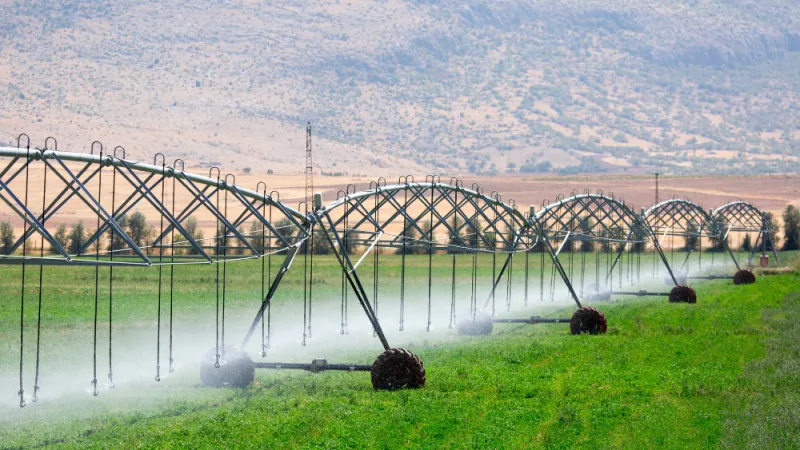Cellular IoT helps farmers use water wisely
As IoT technology evolves, automation will play a more important role by, for instance, automatically stopping the watering process once the soil has received a sufficient level of moisture. Furthermore, analysis of irrigation data transmitted to Cloud computing can help ensure that watering occurs at the optimal time (for example, overnight or at cooler times during the day) to minimize evaporation losses.
This article was first published on
blog.nordicsemi.comOf all the Earth’s precious commodities, water is the most essential to human life. And not just for drinking; over the last 12,000 years water has mainly been used to grow food. Today, more than 70 percent of the planet’s fresh water is used by agriculture (according to World Development Indicators). That puts stress on resources and reduces the amount of water available for other uses, highlighting the importance of reducing the amount of water required to support crops.
But it’s not going to be easy. Factors such as climate change are increasing the challenge. For example, the Bill & Melinda Gates Foundation has forecast that by 2050, 70 percent of crops produced in sub-Saharan Africa will be grown in areas experiencing “extreme” heat stress. That’s going to increase the amount of water plants need, not lower it.
Using IoT sensors to refine water use
The IoT has started to address the problem of water stress. Two reasons for agriculture’s high usage are waste through leakage and lack of information about soil moisture levels leading to overwatering.
By detecting leaks in irrigation systems (which often use many kilometers of piping and tubing) as soon as they occur, shutting off the supply, and notifying farmers via their smartphones, wireless monitoring can both reduce water waste and lessen any damages caused by potential flooding.
To address the second problem, humidity sensors can be used to monitor soil moisture levels. This helps ensure that crops are receiving the exact amount of water they require for maximum yield, while avoiding depletion of precious water resources. The remote control offered by the IoT also helps farmers adjust irrigation using their smartphone or laptop if significant rainfall occurs.
As IoT technology evolves, automation will play a more important role by, for instance, automatically stopping the watering process once the soil has received a sufficient level of moisture. Furthermore, analysis of irrigation data transmitted to Cloud computing can help ensure that watering occurs at the optimal time (for example, overnight or at cooler times during the day) to minimize evaporation losses.
Monitoring sprinkler carts to reduce leaks
Novel irrigation applications include the 7Sense Irrigation Sensor Gen III. The product leverages IoT technology for both leak detection and sprinkler cart management. It employs non-intrusive flow monitoring using vibration detection to sense any loss of water, reducing waste and providing the option to reallocate the manual resources that would normally be spent monitoring irrigation systems. The wireless sensor also provides location monitoring and fleet management, notifying farmers if a cart passes a certain point, or has overturned.
Using Nordic’s cellular IoT SiP, the product sends any leak detection notifications and location updates to the Cloud, where they can be accessed from the 7Sense app on the farmer’s smartphone.
IoT honing flood irrigation
Another example of how the IoT can help with water management is DitchFlow’s Land Irrigation Sensor. The product is designed for use in flood irrigation and can determine when the water has reached the desired level. The product is simply inserted into the ground and can send notifications via email or text using the cellular connectivity of Nordic’s SiP. Irrigators can then decide when to make changes (such as moving water from one area to the next).
Remote monitoring is ideal for situations like this, as farmers would ordinarily have to walk the field to check water levels, often multiple times per irrigation. Using this device, to change the settings for an irrigation channel, farmers only need to go to the ditch where the water is being delivered once they have been notified. This helps reduce the water waste caused by human miscalculations of when the water will reach a desired level.
Agriculture in the home
It’s not just on a large scale that the IoT can be used to monitor water use and improve plant growth. Growgreen’s aspara Smart Grower is an indoor hydroponic planter designed for domestic use, employing moisture sensors in the soil to ensure that each type of plant is receiving the ideal amount of water. The corresponding app allows the user to select the type of plant being grown so the growing conditions can be optimized. Using this technology, the company claims that the aspara Smart Grower can help plants grow up to 50 percent faster.
The device sends a notification to the user’s smartphone via Bluetooth LE when the water tank needs to be refilled. According to Growgreen, the product can reduce water use by up to 90 percent compared to traditional soil farming.
Cellular IoT – the future of smart farming
By 2035, there are expected to be 20 billion connected devices across farms worldwide, while the compound annual growth rate of the smart agriculture market in Europe is predicted to reach 10.6 percent. This growth is underpinned by IoT products that can measure and transmit a wide array of variables, and analyze data to make autonomous decisions to reduce the workload for farmers, increase yield, and minimize the required resources.
Some barriers still exist to the widespread implementation of the IoT in agriculture, largely due to the challenges of data transmission across long distances. However, as cellular IoT and other massive IoT technologies such as DECT NR+ become more ubiquitous in remote and rural areas, smart agriculture will increasingly address the challenges presented by continued population growth, land availability, climate change, and other water stress factors.
This article was first published on Nordic's Get Connected Blog.
